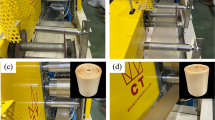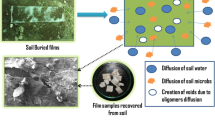Abstract
An investigation was made into polymeric films based on polyvinylpyrrolidone (PVP) as the matrix, in combination with synthetic zeolite and dried or pyrolyzed biocarbon (biochar). The films were prepared by the casting method, and their properties were variously analysed (optical microscopy, FTIR analysis, differential scanning calorimetry, mechanical properties, water solubility, water uptake). Evaluation also encompassed the biological decomposition of the films in the soil environment and their influence on the growth of Sinapis alba. Optical microscopy indicated the particles of the fillers were almost completely evenly distributed in the polymer matrix, therein forming networks randomly. Since the space between the particles decreased as particle content increased, raising the content of the fillers brought about more compact networks. The IR spectra for the films proved the occurrence of hydrogen bonding between the PVP and synthetic zeolite. The processing and mechanical properties of the prepared polymeric films were acceptable. Water solubility and the water uptake of the films were satisfactory regarding handling and further use. Respirometric tests indicated a positive effect by the biocarbon on the biodegradation of the tested films. The proposed combination of synthetic zeolite and biocarbon fillers positively influenced the germination rate of Sinapis alba, while the polymer matrix (PVP) did not hinder further growth. Observations and testing led to the conclusion that the materials based on PVP with fillers (synthetic zeolite/biocarbon) have the potential for agricultural utilization.










Similar content being viewed by others
References
Hopewell J, Dvorak R, Kosior E (2009) Plastics recycling: challenges and opportunities. Phil Trans R Soc B 364(1526):2115–2126. https://doi.org/10.1098/rstb.2008.0311
Faruk O, Bledzki AK, Fink HP, Sain M (2012) Biocomposites reinforced with natural fibers: 2000–2010. Prog Polym Sci 37(11):1552–1596. https://doi.org/10.1016/j.progpolymsci.2012.04.003
Jawaid M, Sapuan SM, Alothman OY (eds) (2016) Green biocomposites: manufacturing and properties. Springer, Berlin. https://doi.org/10.1007/978-3-319-46610-1
Mohanty JR, Das SN, Das HC, Swain SK (2014) Effect of chemically modified date palm leaf fiber on mechanical, thermal and rheological properties of polyvinylpyrrolidone. Fiber Polym 15(5):1062–1070. https://doi.org/10.1007/s12221-014-1062-6
Nešić A, Ružić J, Gordić M, Ostojić S, Micić D, Onjia A (2017) Pectin-polyvinylpyrrolidone films: a sustainable approach to the development of biobased packaging materials. Compos Part B-Eng 110:56–61. https://doi.org/10.1016/j.compositesb.2016.11.016
Acton QA (2013) Polyvinyls-advances in research and application. Scholarly Editions, Georgia
O’Haire T, Russell SJ, Carr ChM (2016) Centrifugal melt spinning of polyvinylpyrrolidone (PVP)/triacontene copolymer fibres. J Mater Sci 51(16):7512–7522. https://doi.org/10.1007/s10853-016-0030-5
Vieira MGA, Silva MA, Santos LO, Beppu MM (2011) Natural-based plasticizers and biopolymer films: a review. Eur Polym J 47(3):254–263. https://doi.org/10.1016/j.eurpolymj.2010.22.011
Arfat YA (2017) Plasticizers for biopolymer films. In: Ahmed J (ed) Glass transition and phase transitions in food and biological materials. John Wiley, Chichester, p 2017
Roy N, Saha N, Kitano T, Saha P (2012) Biodegradation of PVP-CMC hydrogel film: a useful food packaging material. Carbohydr Polym 89(2):346–353. https://doi.org/10.1016/j.carbpol.2012.03.008
Chapi S, Devendrappa H (2016) Optical, electrical, thermal and electrochemical studies of spin-coated polyblend-ZnO nanocomposites. J Mater Sci: Mater Electron 27:11974–11985. https://doi.org/10.1007/s10854-016-5344-1
Mohamed AM, Osman MH, Smaoui H, Ariffin MAM (2017) Permeability and tensile strength of concrete with arabic gum biopolymer. Adv Civ Eng 2017:1–7. https://doi.org/10.1155/2017/4703841
Allison PG, Moser RD, Chandler MQ, Caminero-Rodriguez JA, Torres-Cancel K, Rivera OG, Goodwin JR, Gore ER, Weiss CA (2015) Mechanical, thermal, and microstructural analysis of polyvinyl alcohol/montmorillonite nanocomposites. J Nanomater 2015:9. https://doi.org/10.1155/2015/291248
Babaladimath G, Chapi S (2018) Microwave-assisted synthesis, characterization of electrical conducting and electrochemical xanthan gum-graft-polyaniline. J Mater Sci: Mater Electron 29:11159–11166. https://doi.org/10.1007/s10854-018-9201-2
Chapi S (2020) Optical, electrical and electrochemical properties of PCL5/ITO transparent conductive films deposited by spin-coating-Materials for single-layer devices. J Sci-Adv Mater Dev 5(3):322–329. https://doi.org/10.1016/j.jsamd.2020.07.005
Chapi S (2021) Influence of Co2+ on the structure, conductivity, and electrochemical stability of poly(ethylene oxide)-based solid polymer electrolytes: energy storage devices. J Elec Mater 50:1558–1571. https://doi.org/10.1007/s11664-020-08706-6
Rodriguez-Castellanos W, Rodrigue D (2016) Production and characterization of hybrid polymer composites based on natural fibers. In: Poletto M (ed) Composites from renewable and sustainable materials. Rijeka, Intech, pp 273–302. https://doi.org/10.5772/64995
Alver E, Metin AU, Ciftci H (2014) Synthesis and characterization of chitosan/polyvinylpyrrolidone/zeolite composite by solution blending method. J Inorg Organomet Polym 24:1048–1054. https://doi.org/10.1007/s10904-014-0087-z
Zhang Q, Cai H, Yang K, Yi W (2017) Study of the preparation and properties of biochar/ plastic composites. Results Phys 7:2391–2395. https://doi.org/10.1016/j.rinp.2017.04.025
Behazin E, Misra M, Mohanty AK (2017) Sustainable biocarbon from pyrolyzed perennial grasses and their effects on impact modified polypropylene biocomposites. Compos Part B-Eng 118:116–124. https://doi.org/10.1021/acsomega.7b00122
Mashouf Roudsari G, Misra M, Mohanty AK (2017) A statistical approach to develop biocomposites from epoxy resin, poly(furfuryl alcohol), poly(propylene carbonate), and biochar. J Appl Polym Sci 134(38):45307. https://doi.org/10.1002/app.45307
Nan N, DeVallance DB, Xie X, Wang J (2016) The effect of bio-carbon addition on the electrical, mechanical, and thermal properties of polyvinyl alcohol/biochar composites. J Compos Mater 50(9):1161–1168. https://doi.org/10.1177/0021998315589770
Das O, Bhattacharyya D, Hui D, Lau KT (2016) Mechanical and flammability characterisations of biochar/polypropylene biocomposites. Compos Part B-Eng 106:120–128. https://doi.org/10.1016/j.compositesb.2016.09.020
Giorcelli M, Bartoli M (2019) Development of coffee biochar filler for the production of electrical conductive reinforced plastic. Polymers 11(12):1916. https://doi.org/10.3390/polym11121916
Raya-Moreno I, Cañizares R, Domene X (2017) Comparing current chemical methods to assess biochar organic carbon in a Mediterranean agricultural soil amended with two different biochars. Sci Total Environ 598:604–615. https://doi.org/10.1016/j.scitotenv.2017.03.168
Uzoma K, Inoue M, Andry H, Fujimaki H, Zahoor A (2011) Effect of cow manure biochar on maize productivity under sandy soil condition. Soil Use Manage 27:205–212. https://doi.org/10.1111/j.1475-2743.2011.00340.x
Chen S, Ming Y, Chuang B, Susu Y, Yifei J, Hongtao Z, Yulong Z (2018) Preparation and characterization of slow-release fertilizer encapsulated by biochar-based waterborne copolymers. Sci Total Environ 615:431–437. https://doi.org/10.1016/j.scitotenv.2017.09.209
Jurča M, Julinová M, Slavík R (2019) Negative effect of clay fillers on the polyvinyl alcohol biodegradation. Sci Eng Compos Mater 26(1):97–103. https://doi.org/10.1515/secm-2017-0202
Asaithambi B, Ganesan GS, Kumar SA (2017) Banana/sisal fibers reinforced poly(lactic acid) hybrid biocomposites; influence of chemical modification of BSF towards thermal properties. Polym Compos 38(6):1053–1062. https://doi.org/10.1002/pc.23668
Wanderson F, Ribeiro M, Ryan L, Kotzebue V (2017) Thermal and mechanical analyses of biocomposites from cardanol-based polybenzoxazine and bamboo fibers. J Therm Anal Calorim 129:281–289. https://doi.org/10.1007/s10973-017-6191-x
Baba BO, Ozmen U (2015) Preparation and mechanical characterization of chicken feather/PLA composites. Polym Compos 38(5):837–845. https://doi.org/10.1002/pc.23644
Baba BO, Ozmen U (2017) Thermal characterization of chicken feather/PLA biocomposites. J Therm Anal Calorim 129:347–355. https://doi.org/10.1007/s10973-017-6188-5
Reddy TRK, Rao TS, Suvarna RP, Kumar MA (2013) Prediction on tensile properties of cow dung powder filled glass-polyester hybrid composites. IEEE Conf Ser 2013:702–705
Eze U, Ishidi E, Uche C, Madufor I (2016) Effect of maleic anhydride graft-polyethylene (MAPE) on mechanical properties of cow dung and poultry dung filled low density polyethylene (LDPE) composites. Int J Innov Environ Stud Res 4(1):19–27
Yusefi M, Khalid M, Yasin FM, Abdullah LC, Ketabchi MR, Walvekar R (2018) Performance of cow dung reinforced biodegradable poly (lactic acid) biocomposites for structural applications. J Polym Environ 26(2):474–486. https://doi.org/10.1007/s10924-017-0963-z
Dixit S (2014) Degradation analysis of lignocellulosic fillers infused coir epoxy composites in different environmental conditions. Int J Lignocellul Prod 1(2):160–179. https://doi.org/10.22069/IJLP.2014.2073
Raghuwanshi S, Negi H, Aggarwal T (2015) Comparative biodegradation studies of cow dung modified epoxy with epoxy using an indigenously developed bacterial consortium. Afr J Microbiol Res 9(24):1558–1572. https://doi.org/10.5897/AJMR2015.7462
Khalid M, Ratnam CT, Abdullah LC, Walvekar R, Ching YC, Ketbchi MR (2016) Mechanical and physical performance of cow dung-based polypropylene biocomposites. Polym Compos 39(1):288–296. https://doi.org/10.1002/pc.23928
Roy K, Akhtar A, Schclev SD, Hsu M (2017) Development and characterization of novel biochar-mortar composite utilizing waste derived pyrolysis biochar. Int J Sci Eng Res 8(12):1912–1919
ISO 15705 (2002) Water quality – Determination of the chemical oxygen demand – Small-scale dealer-tube method
Julinová M, Slavík R, Vyoralová M, Kalendová A, Alexy P (2018) Utilization of waste lignin and hydrolysate from chromium tanned waste in blends of hot-melt extruded PVA-starch. J Polym Environ 26(4):1459–1472. https://doi.org/10.1007/s10924-017-1050-1
Costa P, Lobo JMS (2001) Modeling and comparison of dissolution profiles. Eur J Pharm Sci 13(2):123–133. https://doi.org/10.1016/S0928-0987(01)00095-1
Julinová M, Kupec J, Alexy P, Hoffmann J, Sedlařík V, Vojtek T, Chromčáková J, Bugaj P (2010) Lignin and starch as potential inductors for biodegradation of films based on poly (vinyl alcohol) and protein hydrolysate. Polym Degrad Stab 95(2):225–233. https://doi.org/10.1016/j.polymdegradstab.2009.10.008
ISO 11269–2 (2013) Soil quality – Determination of the effects of pollutants on soil flora – Part 2: Effects of chemicals on the emergence and growth of higher plants
Tripathi S, Bhadouria R, Srivastava P, Devi RS, Chaturvedi R, Raghubanshi AS (2020) Effects of light availability on leaf attributes and seedling growth of four tree species in tropical dry forest. Ecol Process 9(1):1–16. https://doi.org/10.1186/s13717-019-0206-4
Naskar MK, Kundu D, Chatterjee M (2011) Influence of PVP buffer layer on the formation of NaA zeolite membrane. J Porous Mater 18(3):319–327. https://doi.org/10.1007/s10934-010-9381-5
Sionkowska A (2003) Interaction of collagen and poly (vinyl pyrrolidone) in blends. Eur Polym J 39(11):2135–2140. https://doi.org/10.1016/S0014-3057(03)00161-7
Liu Y, Yan C, Zhao J, Zhang Z, Wang H, Zhou S, Wu L (2018) Synthesis of zeolite P1 from fly ash under solvent-free conditions for ammonium removal from water. J Clean Prod 202:11–22. https://doi.org/10.1016/j.jclepro.2018.08.128
Cantrell KB, Hunt PG, Uchimiya M, Novak JM, Ro KS (2012) Impact of pyrolysis temperature and manure source on physicochemical characteristics of biochar. Bioresour Technol 107:419–428. https://doi.org/10.1016/j.biortech.2011.11.084
Nagarajan V, Mohanty AK, Misra M (2016) Biocomposites with size-fractionated biocarbon: influence of the microstructure on macroscopic properties. ACS Omega 1(4):636–647. https://doi.org/10.1021/acsomega.6b00175
Mahmoudi Beram F, Koohmareh GA, Malekpour A (2019) Preparation and characterization of aqueous stable electro-spun nanofibers using polyvinyl alcohol/polyvinyl pyrrolidone/zeolite. Soft Mater 17(1):41–56. https://doi.org/10.1080/1539445X.2018.1546191
Saroj AL, Singh RK, Chandra S (2013) Studies on polymer electrolyte poly (vinyl) pyrrolidone (PVP) complexed with ionic liquid: effect of complexation on thermal stability, conductivity and relaxation behaviour. Mater Sci Eng B 178(4):231–238. https://doi.org/10.1016/j.mseb.2012.11.007
Wypych G (2011) Handbook of polymers. Chem Tec Publishing, Canada, p 2011
Bennet GM (2016) Seed inoculation, coating and precision pelleting: science technology and practical applications. CRC Press, USA
Meena RS, Das A, Yadav GS, Lal R (2018) Legumes for soil health and sustainable management. Springer, India
Huang WJ (2017) Engineering applications of biochar. InTech, Croatia
Zhao H, Wu L, Chai T, Zhang Y, Tan J, Ma S (2012) The effects of copper, manganese and zinc on plant growth and elemental accumulation in the manganese-hyperaccumulator Phytolacca americana. J Plant Physiol 169:1243–1252. https://doi.org/10.1016/j.jplph.2012.04.016
Marschner’s MP (2012) Mineral nutrition of higher plants. Elsevier, Australia
Acknowledgements
This research was supported by internal grants from the Tomas Bata University in Zlin no. IGA/FT/2020/009.
Author information
Authors and Affiliations
Corresponding author
Ethics declarations
Conflict of interest
No potential conflict of interest was reported by the authors.
Additional information
Publisher's Note
Springer Nature remains neutral with regard to jurisdictional claims in published maps and institutional affiliations.
Rights and permissions
About this article
Cite this article
Vaňharová, L., Julinová, M., Jurča, M. et al. Environmentally friendly polymeric films based on biocarbon, synthetic zeolite and PVP for agricultural chemistry. Polym. Bull. 79, 4971–4998 (2022). https://doi.org/10.1007/s00289-021-03765-z
Received:
Revised:
Accepted:
Published:
Issue Date:
DOI: https://doi.org/10.1007/s00289-021-03765-z




